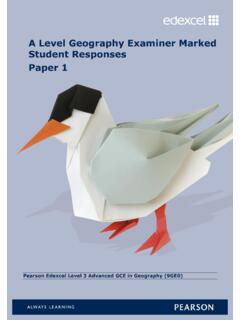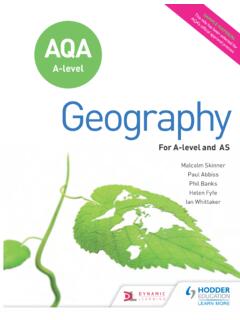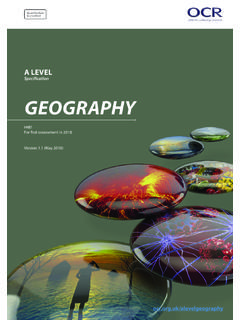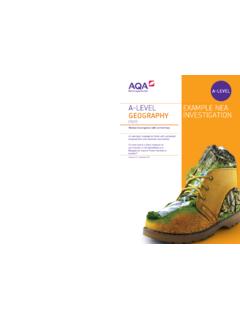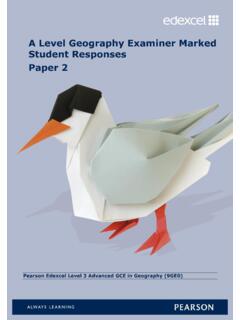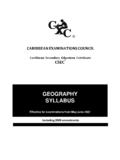Transcription of The Geography of Transport Systems
1 The Geography of Transport Systems Mobility is fundamental to economic and social activities such as commuting, manufac-turing or supplying energy. Each movement has an origin, a potential set of intermediate locations, a destination and a nature which is linked with geographical attributes. Trans-port Systems composed of infrastructures, modes and terminals are so embedded in the socio- economic life of individuals, institutions and corporations that they are often invisible to the consumer. This is paradoxical as the perceived invisibility of transporta-tion is derived from its ef ciency. Understanding how mobility is linked with geo graphy is the main purpose of this book.
2 The third edition of The Geography of Transport Systems has been revised and updated to provide an overview of the spatial aspects of transportation. This text provides more content related to security, energy and environmental issues, as well as new and updated case studies, a revised content structure and new gures. Each chapter covers a speci c conceptual dimension including networks, modes, terminals, freight transporta-tion, urban transportation and environmental impacts. A nal chapter contains core methodologies linked with Transport Geography such as accessibility, spatial interac-tions, graph theory and Geographic Information Systems for Transportation (GIS-T).
3 This book provides a comprehensive and accessible introduction to the eld, with a broad overview of its concepts, methods and areas of application. The accompanying website for this text contains useful additional material, including digital maps, Power-Point slides, databases and links to further reading and websites. The website can be accessed at: This text is an essential resource for undergraduates studying Transport Geography , as well as those interested in economic and urban Geography , Transport planning and engineering. Jean-Paul Rodrigue is Professor in the Department of Global Studies and Geography at Hofstra University, New York.
4 Claude Comtois is Professor of Geography at the University of Montreal, Canada, and is af liated with the Research Centre on Enterprise Networks, Logistics and Transporta-tion at the same institution. Brian Slack is Distinguished Professor Emeritus at Concordia University, Montreal, Canada. This page intentionally left blank The Geography of Transport Systems Third edition Jean-Paul Rodrigue with Claude Comtois and Brian Slack First edition published 2006 by Routledge Second edition published 2009 by Routledge Third edition published 2013 by Routledge 2 Park Square, Milton Park, Abingdon, Oxon OX14 4RN Simultaneously published in the USA and Canada by Routledge 711 Third Avenue, New York, NY 10017 Routledge is an imprint of the Taylor & Francis Group, an informa business 2006, 2009, 2013 Jean-Paul Rodrigue, Claude Comtois and Brian Slack The right of Jean-Paul Rodrigue.
5 Claude Comtois and Brian Slack to be identi ed as authors of this work has been asserted by them in accordancewith sections 77 and 78 of the Copyright, Designs and Patents Act 1988. All rights reserved. No part of this book may be reprinted or reproduced or utilized in any form or by any electronic, mechanical, or other means, now known or hereafter invented, including photocopying and recording, or in any information storage or retrieval system , without permission in writing from the publishers. Trademark notice : Product or corporate names may be trademarks or registered trademarks, and are used only for identi cation and explanation without intent to infringe. British Library Cataloguing in Publication Data A catalogue record for this book is available from the British Library Library of Congress Cataloging in Publication Data Rodrigue, Jean-Paul, 1967- The Geography of Transport Systems / Jean-Paul Rodrigue, Claude Comtois, and Brian Slack.
6 [Third edition]. pages cm Includes bibliographical references and index. 1. Transportation Geography . I. Comtois, Claude, 1954- II. Slack, Brian, 1939- III. Title. 2013 dc232012048389 ISBN: 978 0 415 82253 4 (hbk) ISBN: 978 0 415 82254 1 (pbk) ISBN: 978 0 203 37118 3 (ebk) Typeset in Times New Roman by Re neCatch Limited, Bungay, Suffolk To Gordana and NikolaThis page intentionally left blank Contents List of photographs ix List of gures x List of contributors xiii Preface xiv Chapter 1 Transportation and Geography 1 CONCEPTS: 1 What is Transport Geography ?
7 1 2 Transportation and space 9 3 Transportation and commercial Geography 17 4 The Geography of transportation networks 22 CASE STUDY: Strategic maritime passages 30 Chapter 2 Transportation and the spatial structure 42 CONCEPTS: 1 Historical Geography of transportation: the emergence of mechanized Systems 42 2 Historical Geography of transportation: the setting of global Systems 58 3 Transport and spatial organization 65 4 Transport and location 72 5 Future transportation 77 CASE STUDY: High speed rail Systems 83 Chapter 3 Transportation modes 89 CONCEPTS: 1 A diversity of modes 89 2 Intermodal transportation 110 3 Passengers and freight: complementarity and competition 120 CASE STUDY: Information technologies and mobility 122 Chapter 4 Transportation terminals 127 CONCEPTS: 1 The function of Transport terminals 127 2 The location of terminals 134 3 Transport terminal governance 149 CASE STUDY: Inland ports 152 Chapter 5 International trade and freight distribution 158 CONCEPTS: 1 Transportation, globalization and international trade 158 2 Commodity chains and freight transportation 166 viii Contents 3 Logistics and freight distribution 173 CASE STUDY.
8 Commodity chain analysis: the cold chain 183 Chapter 6 Urban transportation 188 CONCEPTS: 1 Transportation and the urban form 188 2 Urban land use and transportation 198 3 Urban mobility 206 4 Urban Transport problems 212 CASE STUDY: City logistics 219 Chapter 7 Transportation and the economy 226 CONCEPTS: 1 Transportation and economic development 226 2 Transport costs 236 3 Transport supply and demand 243 CASE STUDY: The cruise industry 249 Chapter 8 Transport , energy and environment 255 CONCEPTS: 1 The environmental impacts of transportation 255 2 Transportation and energy 261 3 Transport and sustainability 269 CASE STUDY: Green logistics 274 Chapter 9 Transport planning and policy 280 CONCEPTS: 1 The nature of Transport policy 280 2 Transport planning 285 3 Transport safety and security 291 4 Transportation and disasters 294 CASE STUDY: Transportation and pandemics 299 Chapter 10 Methods in Transport Geography 304 METHODS: 1 Methods in Transport Geography 304 2 Graph theory: de nition and properties 307 3 Graph theory.
9 Measures and indices 312 4 Geographic Information Systems for Transportation (GIS-T) 317 5 The notion of accessibility 322 6 Network data models 328 7 Transport technical and economic performance indicators 333 8 The Gini coef cient 337 9 Spatial interactions and the gravity model 340 10 Market area analysis 345 11 The policy process 351 Conclusion: Issues and challenges in Transport Geography 356 Glossary 364 Index 396 Photographs Container ship exiting the Gaillard Cut, Panama Canal 34 Antwerp Central train station 86 Boarding of a Ryanair ight 103 Forty- foot containers double- stacked on a rail car 115 Stacked container ship 119 Modern airport terminal, Barajas, Madrid.
10 Spain 130 Portainer, APM Terminal, Port Newark, New York 131 Terminal Intermodal Logistica de Hidalgo 156 Third- party less- than-truckload service, FedEx 179 Grocery chain cold storage facility, Regina, Saskatchewan 186 High density structured urban form, Paris, France 193 Bicycle pool, Paris, France 197 BTS Skytrain, Bangkok 211 Parking in a public park, Brussels 217 Cruise ships at the Port of Barcelona, Spain 253 Figures Transportation as a derived demand 2 Different representations of distance 3 The Transport system 7 The great circle distance between New York, Moscow and Tokyo 10 Polar shipping routes 12 Global space/time convergence.
